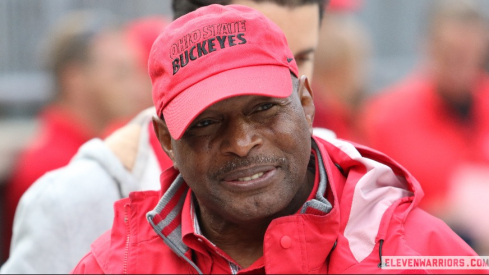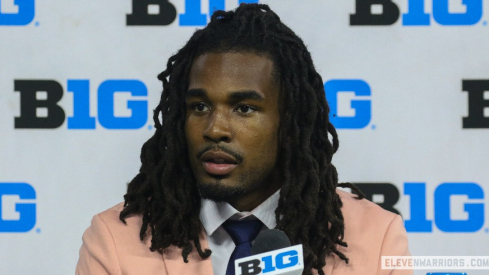
Running a fairly simplified version of their offense, Ohio State's offensive performance against Miami (Ohio) both demonstrated areas for improvement and this offense's large potential. The Buckeye offense was rarely slowed once Ohio State adjusted to Miami's aggressive focus on containing the inside run game. Ohio State's first performance largely confirmed that the offense's strength is that run game, with big plays building off of that from Braxton's Miller's edge-running and play-action passing. Once OSU becomes more proficient in the drop-back pass game they will become a difficult offense to defend.
Questions Answered: Formations and Personnel
Ohio State's initial outing answered questions regarding how OSU's formations and personnel fit together. As expected, the Buckeyes operated primarily from '11' personnel (3 WR, 1 TE, 1 RB), with the TE functioning as a H-Back, generally either just outside the tackle's hip or behind the tackle a yard in the backfield.

Jake Stoneburner generally lined up as the inside flex receiver with Zach Boren as the H-Back. Alternatively, Corey 'Philly' Brown would play the slot receiver and often motion into the backfield, with Stoneburner split farther wide. When Ohio State lined up with a tight end and 'trips' (3 wide receivers to one side), Stoneburner would move to the traditional tight end positions. On passing downs, OSU would feature 10 personnel (4 WR, 1 RB), with an empty backfield and Boren in the H-Back slot.
OSU employed far less personnel substitution then was evidenced during the Jim Tressel era. Ohio State's offensive line remained set with (L-R) Jack Mewhort, Andrew Norwell, Corey Linsley, Marcus Hall, and Reid Fragel. Carlos Hyde played nearly all meaningful snaps from the tailback position. Brown, Devin Smith, Stoneburner, and Evan Spencer saw the most meaningful minutes at the wide outs, with Boren or Stoneburner almost exclusively at the 'flex position.'
The First Quarter: A Case of Jitters with a Side Of Miami Sell-Out
With so much offseason hype regarding Urban Meyer's new Ohio State offense, the expectations starting the Miami game were palpable, perhaps no more so than for the Buckeye players themselves The opening game jitters were evident, particularly for Braxton Miller. Miller was simply too jittery in the opening sequences, failing to set his feet and therefore delivering inaccurate footballs to open receivers, making it difficult for the Buckeyes to move the football through the air.
Miami's defensive approach also presented the Buckeyes with problems. Miami had prepared for the above formation and defending Meyer's inside zone read play. To do so, the RedHawks put seven defenders in the box in a 4-3 stack. They would have their backside defensive end play the zone run and use a scrape exchange, while having their backside safety come up at the snap to be responsible for Miller. The front side two linebackers would pinch the inside 'A' gaps, while the front side safety also was within ten yards of the line of scrimmage. The result was a defensive numbers advantage, with seven defenders to play the zone at the point of attack, while still alloting two defenders to Miller. Note in the clip below that the frontside linebacker, who is ostensibly covering up Stoneburner, immediately attacks down in the frontside 'A' gap. OSU simply does not have a blocker to allocate to him, allowing him to make the tackle.
In other words, Miami was daring Ohio State to throw the football. Combine that with the inability to hit open receivers in the drop back game and it led to OSU's first quarter struggles.
Adjustments, Adjustments
The Ohio State offensive coaching staff quickly adjusted, however. The first alteration was emphasizing more play-action passing over the drop back game. This used Miami's aggressiveness against them and also seemed more comfortable to Miller. The coaching staff took Miller out of the pocket, used play-action to hold the safeties, took away half the field, and gave Miller some simple reads and throws to get a rhythm established.
Note in the second example how Miami's safety attacks the line of scrimmage on the play fake, leaving not enough RedHawk defenders for the Buckeye receivers. Relatedly, OSU also employed sprint-out passing, a Meyer staple, which again seemed to fit Miller's comfort zone.
OSU also altered the pre-snap looks they gave the RedHawks. As Meyer discussed in his post-game press conference, the Buckeyes began working from trips. This forced Miami out of the game they were playing with their safeties above, as one safety had to favor the three receiver side. OSU also had the TE/H-Back arc release around the end to block the safety on the backside of the zone read. Finally, OSU put the trips into the boundary, again precluding Miami from having their safeties attack the run game.
We got a couple of formations later, the big one, where we kind of out-formationed them a little bit. It was a great sideline adjustment, halftime, we put all the players in a boundary. That was the 80 or 90 yard run, whatever he had.
Stoneburner was able to stalk block the remaining safety, and Miller was off to the races.
The Buckeyes also unveiled a QB counter-trey draw with Zach Boren as lead blocker from empty formations, again revealing Meyer's preference for power plays from spread formations.
OSU was thus able to quickly turn the tide by slightly altering their approach and employing constraint plays against an overaggressive defense.
K.I.S.S.
That said, OSU kept their offense fairly basic in their initial outing. The overwhelming percentage of run plays were inside zone read. Meyer runs the inside zone differently, having the tailback attack the center's backside leg. The result is the play has more of a dive feel.
The run game was kept so basic that even Meyer staples such as counter-trey were used sparingly. OSU also stuck to Meyer staples in the pass game, such as follow and H-T option, particularly on third down.

Meyer and Tom Herman's goal was likely to slowly build the offense in game conditions, allowing the Buckeyes to gain some comfort. But OSU has the potential to show a lot more from the playbook than what was run Saturday, even amongst their 'base' plays.
Player Growth
Of course, perhaps no player's growth is more important than Braxton Miller's. Miller's game demonstrated his talents, where he had grown, but also what he must continue to improve. As discussed, Miller currently looks more comfortable running the football or on the move in play-action than he does in the drop back pass game. Miller continually made the correct read in the zone read game, a crucially important task for a QB in this system. Braxton's effectiveness in the drop-back passing game, though, was mixed, often stemming from his footwork. For example, below is follow on 3rd down. Corey Brown comes open on the shallow cross route, but rather than pulling the trigger, Miller bails from the pocket after feeling some pressure.
Yet you can also see Miller's development. For instance, here the Buckeyes run a route combination of curl-flat with levels. Miller reads a single-high safety and correctly works the curl-flat combination. Unfortunately, Boren gets tripped up so Miller works back across the field.
Nevertheless, the downfield pass game remains the weakest point of the OSU attack. Expect defenses to continue to attack the Buckeyes like Miami did this week until Ohio State is able to consistently punish defenses for taking such an approach.
OSU as an offense had similar growing pains. Some of this was in communication. At times it was clear that not everyone got the correct signals in the no-huddle, leading to miscommunication. Other times it was simply inconsistent execution. Carlos Hyde is a good example of this. Hyde ran hard and does a great job not taking contact straight on and getting yards after contact. On the other hand, he needs to exercise more patience and vision in hitting open holes. Yet he is also a young player who can greatly improve as he works on his vision.
The offensive line play was also a bright spot. This line is always going to be helped out by scheme in relation to previous Buckeye units through the use of option football, removing defenders who must be blocked. Nonetheless, the line performed very well for a relatively inexperienced unit. Miami stunted and twisted every passing down. The offensive line did a nice job of picking up the twists and generally controlled the line of scrimmage.
As discussed, most negative plays were caused by Miami simply putting more defenders than OSU had blockers at the point of attack. Reid Fragel looked fairly comfortable pass blocking in his first real action at right tackle. Miami continually tried to speed rush him but Fragel did a nice job moving his feet and riding the defender upfield. This has to be an encouraging performance for both Fragel and the coaching staff.
In addition, though he did not have a highlight like Devin Smith's catch, Philly Brown's performance was very encouraging, both in the underneath pass game and in the backfield. Brown plays a crucial role as the slot receiver in this offense where a dynamic playmaker is desired, particularly on third down as the receiver responsible for running the option and shallow crossing routes. He is the one player with the versatility to both do that and come in motion as a pitch option. His emergence as a primary threat is therefore a promising sign for OSU.
As the old cliche goes, a team makes its biggest improvement between its first and second game. Given that OSU gained over 500 yards of offense, it demonstrates the potential upside as they fully implement the offense and clean up these fixable mistakes.

